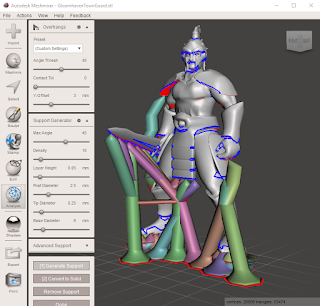How Much Filament Do I Have Left

As I approached the end of another roll of filament, I asked myself, "how much filament do I have left?" I was getting ready to leave for work and didn't want the printer sitting idle all day with a half-finished print sitting on the bed, but I also didn't want to just put on a new roll and waste a bunch of perfectly good filament. What to do? Well, the answer was obvious, hit Google!
Unfortunately, no answer was readily available. Filament spools do not have standard sizes, so there's no rule-of-thumb like, "the last layer has 10 meters of filament" or the like. Annoyed at my lack of results, I thought more about the problem and eventually reframed it for myself. What I had here wasn't a 3D printing problem, one that might require the epic expertise of a Joel, an Angus, or a Thomas... what I had here was a simple applied math problem. I got out my calipers and went to work.
My filament spool has those helpful little cutouts on the side, and the bottoms of those windows line up nicely with the top of the core of the spool. So, I put the ends of my calipers into two opposing cutouts, then rotated them so that they would be pressed up against opposite edges of the holes (one end against the left edge, the other against the right). I figured that would be an easy way to get the actual diameter of the spool core, rather than the near-to-the-diameter measurement that I would have gotten had I tried to eyeball it in the middle of the slots. I measured it as a smidge over 104.4 mm.
I know that my filament is 1.75 mm thick, so the center of a strand of filament that's wrapped tightly around that spool must describe a circle with a 106.15 mm diameter. I got that number by this process: Spool Diameter + Filament Thickness * 2 (because it's on both ends of that diameter line) / 2 (because I'm interested in the center of the filament strand, not the outside edge). 104.4 + 1.75 * 2 / 2 = 106.15.
Now that I had the smallest diameter that a single loop of filament could be (it's assuming that the filament is wound perfectly against the core of the spool with no lateral drift and no loose sag), simple geometry could tell me the minimum length that is represented by each loop of filament. 106.15 * pi = 333.4 mm of filament per loop around the core of this spool. Well, that converts nicely into a human friendly measurement: each loop is a tiny bit more than 1/3 of a meter.
So, I looked at the job that I wanted to start before going to work. Slic3r estimated that it was going to need a bit under 4 meters of filament, so all I had to do was to count the loops on my spool and ensure that I had at least 12 (also, I had some flex-room, due to the filament that was already off of the spool and heading down into the extruder). I stopped counting at 15 loops and went to work, confident that I'd have plenty of plastic to run today's daytime print.


Thanks for this blog post! It helped :)
ReplyDelete